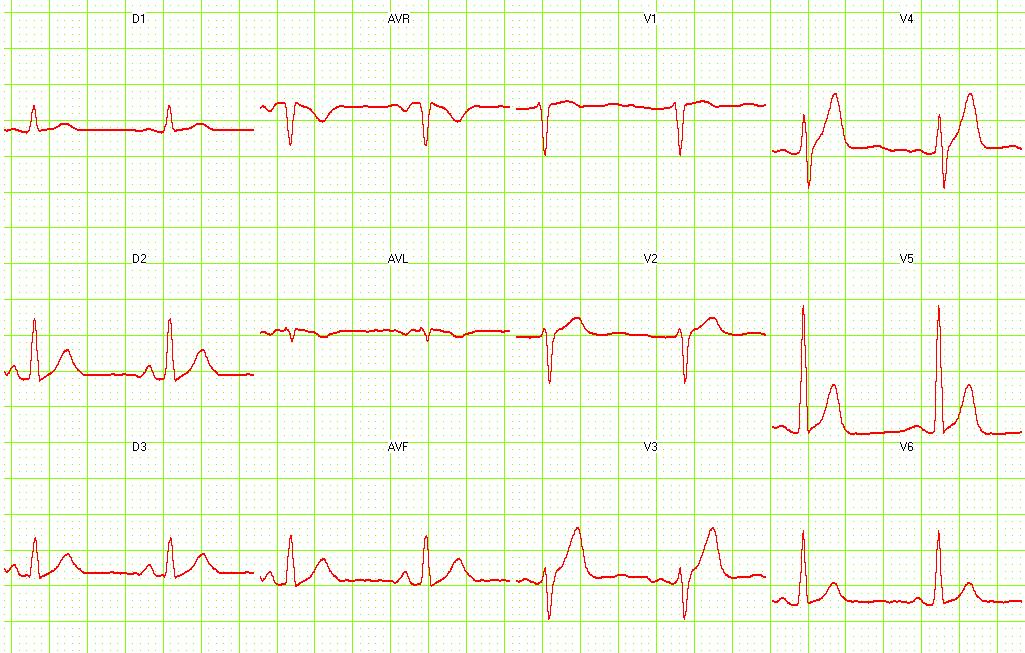Hypercalcemia electrocardiogram: Difference between revisions
Jump to navigation
Jump to search
No edit summary |
No edit summary |
||
| (7 intermediate revisions by 3 users not shown) | |||
| Line 1: | Line 1: | ||
__NOTOC__ | |||
{{Hypercalcemia}} | {{Hypercalcemia}} | ||
{{CMG}} | {{CMG}}; {{AE}} {{Anmol}} | ||
==Overview== | ==Overview== | ||
==Electrocardiogram Findings== | Most common finding on ECG due to hypercalcemia is short [[QT interval]]. | ||
==Electrocardiogram== | |||
Findings on [[ECG]] are due to [[hypercalcemia]] and includes:<ref name="pmid8201301">{{cite journal |vauthors=Lind L, Ljunghall S |title=Serum calcium and the ECG in patients with primary hyperparathyroidism |journal=J Electrocardiol |volume=27 |issue=2 |pages=99–103 |year=1994 |pmid=8201301 |doi=10.1016/S0022-0736(05)80092-5 |url=}}</ref><ref name="pmid27867906">{{cite journal| author=Kelwade JV, Modi KD, Kumar N, Parekh H| title=Hypercalcemia and electrocardiogram changes. | journal=Indian J Endocrinol Metab | year= 2016 | volume= 20 | issue= 6 | pages= 892-893 | pmid=27867906 | doi=10.4103/2230-8210.192900 | pmc=5105587 | url=https://www.ncbi.nlm.nih.gov/entrez/eutils/elink.fcgi?dbfrom=pubmed&tool=sumsearch.org/cite&retmode=ref&cmd=prlinks&id=27867906 }}</ref> | |||
[[image:Ganseman.Hypercalcemia.jpg|center|400px|thumb|12 lead EKG:Hypercalcemia. [http://www.ganseman.com/ecgbibnl.htm#_top000 Courtesy of Dr Jose Ganseman]]] | *[[QT interval]] - Short QT interval is seen in pateints if hypercalcemia. | ||
*[[ST segment]] - [[ST segments|ST segment]] is short in patients with hypercalcemia when compared to normocalcemic patients. This represents a decrease in [[systolic]] interval. | |||
*[[QRS complex]] - [[QRS complex]] has an increased amplitude in patients with hypercalcemia when compared to normocalcemic patients. This represents an increase in [[ventricular]] muscle mass. | |||
*[[T wave]] - [[T wave]] is prolonged in patients with hypercalcemia when compared to normocalcemic patients. | |||
'''Note:''' Severe hypercalcacemia may mimic acute myocardial infarction.<ref name="pmid19435131">{{cite journal| author=Wesson LC, Suresh V, Parry RG| title=Severe hypercalcaemia mimicking acute myocardial infarction. | journal=Clin Med (Lond) | year= 2009 | volume= 9 | issue= 2 | pages= 186-7 | pmid=19435131 | doi= | pmc= | url=https://www.ncbi.nlm.nih.gov/entrez/eutils/elink.fcgi?dbfrom=pubmed&tool=sumsearch.org/cite&retmode=ref&cmd=prlinks&id=19435131 }}</ref>[[image:Ganseman.Hypercalcemia.jpg|center|400px|thumb|12 lead EKG:Hypercalcemia. [http://www.ganseman.com/ecgbibnl.htm#_top000 Courtesy of Dr Jose Ganseman]]] | |||
==References== | |||
{{reflist|2}} | |||
[[Category:Needs content]] | [[Category:Needs content]] | ||
[[Category:Disease]] | |||
[[Category:Endocrinology]] | |||
[[Category:Emergency medicine]] | |||
[[Category:Cardiology]] | |||
{{WS}} | |||
{{WH}} | |||
Latest revision as of 23:17, 8 July 2018
|
Hypercalcemia Microchapters |
|
Diagnosis |
|---|
|
Treatment |
|
Case Studies |
|
Hypercalcemia On the Web |
|
American Roentgen Ray Society Images of Hypercalcemia |
Editor-In-Chief: C. Michael Gibson, M.S., M.D. [1]; Associate Editor(s)-in-Chief: Anmol Pitliya, M.B.B.S. M.D.[2]
Overview
Most common finding on ECG due to hypercalcemia is short QT interval.
Electrocardiogram
Findings on ECG are due to hypercalcemia and includes:[1][2]
- QT interval - Short QT interval is seen in pateints if hypercalcemia.
- ST segment - ST segment is short in patients with hypercalcemia when compared to normocalcemic patients. This represents a decrease in systolic interval.
- QRS complex - QRS complex has an increased amplitude in patients with hypercalcemia when compared to normocalcemic patients. This represents an increase in ventricular muscle mass.
- T wave - T wave is prolonged in patients with hypercalcemia when compared to normocalcemic patients.
Note: Severe hypercalcacemia may mimic acute myocardial infarction.[3]

References
- ↑ Lind L, Ljunghall S (1994). "Serum calcium and the ECG in patients with primary hyperparathyroidism". J Electrocardiol. 27 (2): 99–103. doi:10.1016/S0022-0736(05)80092-5. PMID 8201301.
- ↑ Kelwade JV, Modi KD, Kumar N, Parekh H (2016). "Hypercalcemia and electrocardiogram changes". Indian J Endocrinol Metab. 20 (6): 892–893. doi:10.4103/2230-8210.192900. PMC 5105587. PMID 27867906.
- ↑ Wesson LC, Suresh V, Parry RG (2009). "Severe hypercalcaemia mimicking acute myocardial infarction". Clin Med (Lond). 9 (2): 186–7. PMID 19435131.